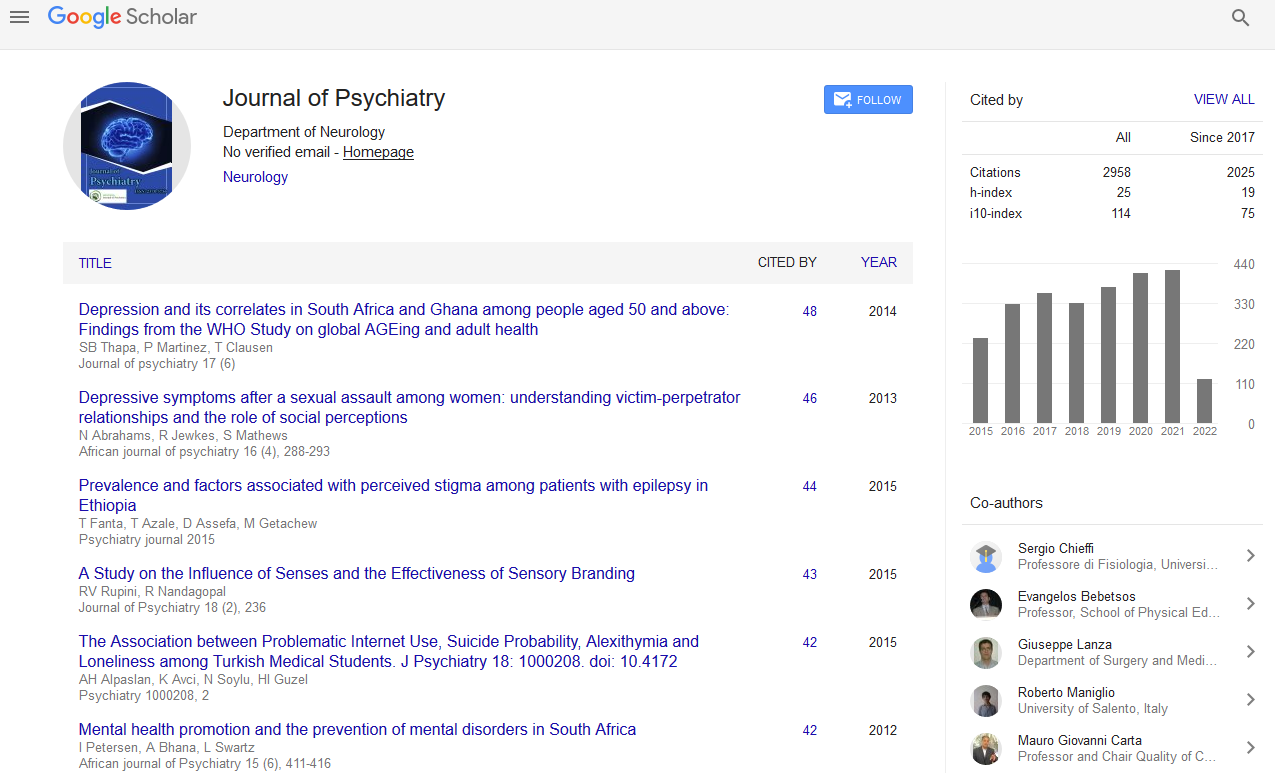PMC/PubMed Indexed Articles
Indexed In
- RefSeek
- Hamdard University
- EBSCO A-Z
- OCLC- WorldCat
- SWB online catalog
- Publons
- International committee of medical journals editors (ICMJE)
- Geneva Foundation for Medical Education and Research
Useful Links
Share This Page
Open Access Journals
- Agri and Aquaculture
- Biochemistry
- Bioinformatics & Systems Biology
- Business & Management
- Chemistry
- Clinical Sciences
- Engineering
- Food & Nutrition
- General Science
- Genetics & Molecular Biology
- Immunology & Microbiology
- Medical Sciences
- Neuroscience & Psychology
- Nursing & Health Care
- Pharmaceutical Sciences
Correlation between improvement of defecation pattern and altered fMRI activity after biofeedback therapy in patients with dyssynergic defecation
5th International Conference on Psychiatrist, Geriatric Psychiatry and Counseling Psychology
December 08-09, 2016 San Antonio, USA
Afsaneh Nikjooy, Nader Maroufi, Mojtaba Zarei, Hassan Ashayeri, Esmaeil Ebrahimi, Bahar Mahjoubi and Homayoun Hadizadeh Kharazi
Iran University of Medical Sciences, Iran
Shahid Beheshti University, Iran
Scientific Tracks Abstracts: J Psychiatry
Abstract:
Statement of the Problem: Chronic constipation is an annoyingly common bowel problem which has significant impact on health expenses and quality of life. Up to 50% of chronic constipation patients are outlet dysfunction type constipation, which divided into structural and functional causes. Functional defecation disorders include dyssynergic defecation (paradoxical contraction or failure to relax the pelvic floor and anal muscles during defecation). Patients with dyssynergic defecation are often unresponsive to traditional conservative medical treatments, and surgical methods have poor benefit and can lead to anal incontinence. Therefore, behavioral treatment such as biofeedback therapy is probably the best choice for this kind of functional disability. Aim: The purpose of this study was to compare the efficacy of biofeedback therapy with standard therapy in dyssynergic defecation patients. Methodology & Theoretical Orientation: In a randomized clinical trial, in 19 dyssynergic defecation patients, before and after treatment, pattern of defecation during straining was assessed using MRI defecography and brain fMRI. Findings: This study showed that; the improvement of defecation function and pelvic floor motion indices (anorectal angle change and perineal motion) after biofeedback therapy have been associated with increased fMRI activity in Parietal Operculum, Insular Cortex, Lingual Gyrus and left Thalamus, during defecation compared with rest position. Also brain activation pattern in patients who had received standard therapy didn�??t change post-treatment and was; Central Opercular cortex, Insular and Orbitofrontal Cortex. Conclusion & Significance: The post-treatment alteration in brain activity pattern in biofeedback therapy group in comparison to standard therapy group during defecation was remarkable in this study. This change that coincides with increased relaxation of pelvic floor and sphincter muscles in biofeedback therapy group may reflect neural reorganization of the brain and changes in behavior, resulted from this approach.
Biography :
Afsaneh Nikjooy is an Assistant Professor of Physical Therapy, Department of Physical Therapy, at Iran University of Medical Sciences, Tehran, Iran. She is a member of the International Continence Society (I.C.S) and Iranian Continence Society (Ir.C.S). She has worked in pelvic floor physical therapy for more than 14 years. She has managed several courses of pelvic floor physical therapy for master students in this field in Faculty of Rehabilitation, Iran University of Medical Sciences.
Email: afsanehnikjooy@yahoo.com


